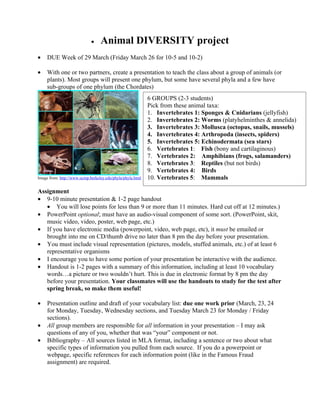
Animal DIVERSITY Project Presentations and Readings
- 1. • Animal DIVERSITY project • DUE Week of 29 March (Friday March 26 for 10-5 and 10-2) • With one or two partners, create a presentation to teach the class about a group of animals (or plants). Most groups will present one phylum, but some have several phyla and a few have sub-groups of one phylum (the Chordates) 6 GROUPS (2-3 students) Pick from these animal taxa: 1. Invertebrates 1: Sponges & Cnidarians (jellyfish) 2. Invertebrates 2: Worms (platyhelminthes & annelida) 3. Invertebrates 3: Mollusca (octopus, snails, mussels) 4. Invertebrates 4: Arthropoda (insects, spiders) 5. Invertebrates 5: Echinodermata (sea stars) 6. Vertebrates 1: Fish (bony and cartilaginous) 7. Vertebrates 2: Amphibians (frogs, salamanders) 8. Vertebrates 3: Reptiles (but not birds) 9. Vertebrates 4: Birds Image from: http://www.ucmp.berkeley.edu/phyla/phyla.html 10. Vertebrates 5: Mammals Assignment • 9-10 minute presentation & 1-2 page handout • You will lose points for less than 9 or more than 11 minutes. Hard cut off at 12 minutes.) • PowerPoint optional; must have an audio-visual component of some sort. (PowerPoint, skit, music video, video, poster, web page, etc.) • If you have electronic media (powerpoint, video, web page, etc), it must be emailed or brought into me on CD/thumb drive no later than 8 pm the day before your presentation. • You must include visual representation (pictures, models, stuffed animals, etc.) of at least 6 representative organisms • I encourage you to have some portion of your presentation be interactive with the audience. • Handout is 1-2 pages with a summary of this information, including at least 10 vocabulary words…a picture or two wouldn’t hurt. This is due in electronic format by 8 pm the day before your presentation. Your classmates will use the handouts to study for the test after spring break, so make them useful! • Presentation outline and draft of your vocabulary list: due one work prior (March, 23, 24 for Monday, Tuesday, Wednesday sections, and Tuesday March 23 for Monday / Friday sections). • All group members are responsible for all information in your presentation – I may ask questions of any of you, whether that was “your” component or not. • Bibliography – All sources listed in MLA format, including a sentence or two about what specific types of information you pulled from each source. If you do a powerpoint or webpage, specific references for each information point (like in the Famous Fraud assignment) are required.
- 2. Information requirements • What is the meaning of the scientific name for this clade(s)? • Does this group have symmetry? If so, what kind? • How does this phylum fit into the evolutionary tree (cladogram)? Which other group (from your list) is most closely related? How long ago did humans share a common ancestor with this group? • Explain derived characteristics that are unique to that clade. What distinguishes these organisms from other groups? • Explain at least 3 of these about your group: • How do they reproduce? • What is their life cycle? (eggs, larvae, juvenile, adult, etc) • How do they obtain food? How is it digested? • How are gases, food/wastes exchanged with the environment (respiration/circulation)? • How do they avoid predation/disease? • How do they move (if they move)? • How does the organism maintain control (nervous system)? • Describe at least 3 representative organisms (with both Latin and common names), including habitat, range, what they eat, locomotion, ecological role/niche, and life cycle changes. • If you have multiple phyla/groups, include at least 1 representative from each. If you have a phylum, try to look at different classes. If you have a class, look at different orders. • What are human uses/interactions with organisms in this group? (We eat them, they make us sick, etc.) • FUN FACT – include a fun trivia question about your group. GRADING Draft/Outline (due one week early): 5 points Presentation: 30 points Information Content (20 points) Effectiveness of Presentation (10 points) Handout: 15 points Information content (12 points) Presentation / Layout (3 points) Group Participation: 5 points Total: 55 points Another Powerpoint on Plant Diversity – a good one http://www.slideshare.net/walajtys/biology-chapter-22-plant-diversity http://www.ucmp.berkeley.edu/exhibit/phylogeny.html UC Berkeley Museum of Paleontology – very helpful starting point http://tolweb.org/Animals/2374 Animal section of the Tree of Life web project. Phylum Chordata: http://science.nhmccd.edu/BioL/animal.html#chordata Online Textbook http://www.emc.maricopa.edu/faculty/farabee/BIOBK/BioBookTOC.html Encylopedia of Life www.eol.org
- 3. WEDNESDAY SECTIONS UPDATE!!! Biodiversity Unit Reading Biodiversity (~11 pages) 25.3 History of Life (p514 – 519) 26.1 Phylogeny (p536 – 540) 26.3 Cladistics and Shared ancestral and Shared Derived Characteristics only (p542-543) Plant diversity (~17 pages) Seedless plants (Mosses & Ferns ~10 pages) p 601, 604 (Adaptations enabling the move to land) p602 Alternation of Generations (Figures 29.5, 29.7) 29.2 Mosses (606-607, 609) 29.3 Ferns (p610 – 612, 615) Seed Plants (Angiosperms & Gymnosperms) (~7 pages) Ch 30 Overview p618 30.1 (618-620) 30.2 (621, 625) 30.3 (625-626 only) QUIZ March 24 on Biodiversity and Plant Diversity (Seed and Seedless Plants) (20 points) The reading below will be on the test after spring break and will be helpful for your projects. Animal Diversity (~6 pages) 32.1 Animals are multicellular, heterotrophic eukaryotes…(Pg 654-655) 32.2 History of animals…(Pg 656 – 658) 32.3 Body Plans (p 658 – 659, focus on symmetry) Invertebrate (~4 pages) Ch 33 Overview: Life Without a Backbone (p 666 – 669), including Figure 33.3 and p696 Vertebrates (~3 pages) Ch 34 Overview: Half a Billion Years of Backbones 34.3 Vertebrates p704-705, 734 Suggested (not required) reading by group Sponges & Cniderias: p 670 – 673 (33.1 & 33.2) Worms: 33.3 (p 674 – 676), (p680- 682), 33.4(p683 on nematodes) Molluscs: p677-680 Arthropods: 33.4 (p684-692) Echinoderms: 33.5 (p693-695) All Vertebrate groups: 34.4 intro (p705-706) Fishes: Chondrichthyans & Fishes (p706-710) Amphibians, Birds, Reptiles, Mammals: 34.5 (p710-711) Amphibians: (711-713) Birds, Reptiles, Mammals: 34.6 (p713-715) Reptiles (715-718) Birds (718 – 720) Mammals: p513, 34.7 (720-728)